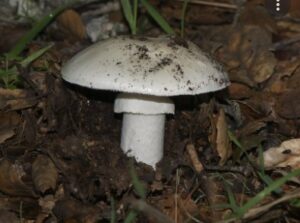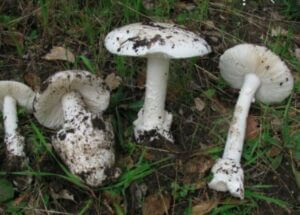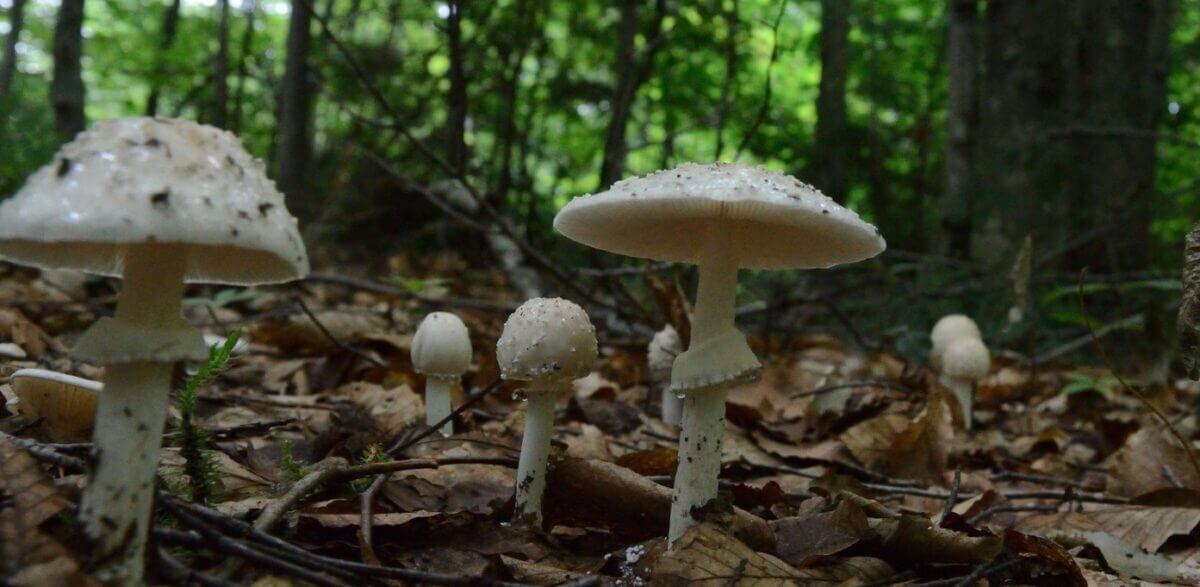Every lawn is unique and can experience different kinds of problems.
One such annoyance is the presence of toadstools, which are neither attractive nor desired since they detract from the beauty of your grass and make it difficult to enjoy the space.
But don’t worry: we’ll show you how to get rid of these pesky mushrooms once and for all.
We’ve put together a comprehensive guide designed to help you tackle this problem head-on, including expert advice on the best ways to get rid of them without resorting to costly professional help.
Read this blog post now to learn how to remove toadstools from your lawn and keep them away for good!
Top Rated Toadstool Remover for Lawns
| Recommended Products | Product | Buy on Amazon |
 | Garden Safe Brand Fungicide3, Ready-to-Use, 24-Ounce | Check Latest Price |
 | Scotts DiseaseEx Lawn Fungicide | Check Latest Price |
Why You Have Toadstools in Lawn
Here are 5 reasons you have toadstools in your lawn:
1. You have a shady lawn.
If you’ve got trees giving your lawn a shady spot, then you’re likely to come across some toadstool mushrooms. These fungi thrive in areas with plenty of shade, and so the conditions of your garden help make them feel right at home.
In fact, some species of mushrooms can only be found in areas shaded by trees, so having this kind of environment in the backyard can be quite beneficial for the mushroom lover.
Not only will you have all sorts of unique mushrooms growing in your backyard, but you’ll also be providing a home and sanctuary for these amazing organisms.
So if you want to attract more than just the squirrels and chipmunks to your lawn, then consider introducing trees or other forms of shade to serve as a haven for both you and the lovely toadstool mushrooms.
2. You have a wet lawn.
If your lawn is regularly and consistently kept in a damp state, it’s an ideal location for mushrooms to sprout up and flourish.
Toadstools have a tendency to thrive and grow in these humid, moisture-rich environments, making them a natural fit for lawns that remain moist for extended periods of time.
This is because mushrooms rely on the dampness from their environment in order to reproduce.
Consequently, if you notice an abundance of toadstools growing in your yard, it may very well be due to the presence of high moisture in the soil.
3. You have poor drainage in your yard or garden beds.
If water lingers at the surface of the soil, it can create the ideal conditions for toadstools to sprout and spread their spores.
Unchecked, these toadstools can easily spread and proliferate, transforming a once dull, dry landscape into one teeming with life and color.
Toadstools are in fact incredibly important to our ecosystems, as they provide an abundance of nutrients that many other organisms rely on for food, creating a healthy and balanced environment.
It’s important to be mindful of where and when toadstools pop up, as they can cause a great deal of damage when they overtake an area of land.
With proper care and attention, however, toadstools can provide much needed sustenance for the wider ecosystem and make otherwise uninviting spaces come alive with natural beauty.
4. Your soil is rich in organic matter.
The moist and humid conditions of the forest floor are perfect for fungi to flourish.
Mushrooms, toadstools, and other mushrooms species find their ideal environment in the wet and dark environment of the forest.
These fungi species have adapted to thrive in these specific conditions, as they rely on the moisture for their survival.
Such a hospitable environment for these fungi allows them to spread across the forest floor, giving the area a unique look and smell.
Not only does this give us a great opportunity to observe this unique set of fungi, but it also helps us to understand more about how the environment works.
5. You may be spreading the spores yourself!
If you’re looking to take your garden to the next level, it’s important to be mindful of potential fungi hitchhikers.
When transplanting or propagating plants from one area to another, you may inadvertently transport some unwanted fungi as well.
Fungi can often be found on the roots of plants and easily hidden during the process of digging or cutting.
Taking the time to inspect and clean your plants before adding them to your garden is essential to avoiding any unwanted fungal diseases that can spread to your other plants and cause detriment.
While it can be tedious task, a little extra effort can go a long way in keeping your garden healthy and vibrant.
Toadstools In Lawn Are They Poisonous?
Many people wonder if mushrooms growing in their yard are dangerous.
Fortunately, the answer is mostly no; depending on the type of mushroom.
Lawn mushrooms, for example, are generally harmless to humans and pets, and in fact can be beneficial to the soil by decomposing dead organic matter and thereby returning nutrients back into the earth.
These mushrooms are usually white, tan or brown, with flat, rounded caps that are less than three inches across, and lack gills underneath the cap.
On the other hand, there are some mushrooms that are poisonous, and they can be identified by their unique color, shape, and size.
These mushrooms include species such as Amanita bisporigera, Amanita phalloides, and Galerina marginata, among others.
It is important to recognize the difference between these mushrooms and their benign counterparts, as ingestion of any mushroom can result in serious harm or even death.
As such, it is recommended to err on the side of caution, and avoid contact with any unidentified mushrooms growing in your lawn.
Death Cap Mushrooms (Amanita phalloides)

Be warned – death caps may be easy to mistake for edible puffball mushrooms due to their similarity in appearance.
Death caps have a greenish-brown cap, while edible puffball mushrooms are usually white or yellowish-white.
However, consuming a death cap mushroom can be incredibly dangerous, as it contains toxins that can cause liver failure as soon as 12 hours after ingestion.
Symptoms such as vomiting, diarrhea, stomach cramps, pain, fever, and chills usually appear within two to three hours following the eating of a death cap mushroom.
If you suspect someone has ingested a death cap mushroom, act fast – call the Poison Control Center at 1-800-222-1222 for information on treatment options.
Awareness and quick action are the best ways to protect yourself from the potential life-threatening consequences of consuming death cap mushrooms.
Destroying Angels (Amanita bisporigera)

Destroying angels are a highly toxic fungus that can cause serious health problems when consumed.
Though they look very similar to the death cap, there are several clear differences.
While the death cap has a stemless base and straight grooves under its top layer of skin, the destroying angel has a bulbous base and wavy ridges beneath its cap.
Both mushrooms contain toxins that can cause severe digestive issues if ingested, such as nausea, vomiting, diarrhea, and stomach cramps, as well as potentially fatal liver failure within 24 hours of consumption.
Other symptoms include high fever, chills, and dehydration in cases where treatment is not sought quickly enough.
Any suspected mushroom ingestion should be treated as a medical emergency, and poison control should be contacted immediately at 1-800-222-1222 for instructions on available treatments.
Why Toadstools Aren’t Always Harmful
Toadstools are often misinterpreted as a nuisance in lawns, however they can be seen more like a harmless part of nature.
These fungi are essentially the same species as mushrooms, except for one key difference – toadstools haven’t reached the fruiting body stage, which is where spores are produced for reproduction.
That’s why toadstools don’t spread nearly as fast or wide as mushrooms, even in ideal conditions.
Despite this, the lawn remains a popular place for them due to its moist and warm environment, often appearing alongside flower beds and mulch beds.
Why Toadstools in Lawn Can Be Harmful
Here are 6 reasons why toadstools are harmful for your lawn:
1. Toadstools are very hard and dense
Toadstools may be unsightly and quite difficult to mow around, but if you don’t remove them from your lawn, you risk causing a lot of damage to both your lawn mower blades and even worst, the machine itself.
Not only can the hardiness of these fungi cause your blades to bend or break, but the spores they emit can also get stuck in the underside of your mower and clog it up.
This can cause your mower to malfunction or even completely cease working.
Thankfully, there are ways to safely and effectively remove these toadstools without putting yourself or your lawn mower at risk.
2. Toadstools can easily damage your lawn mower blades
Toadstools can be a nuisance in any lawn, as they can easily become tangled up in and damage the blades of your mower if you try to cut them.
Unfortunately, regular mowing won’t get rid of toadstools – the only way to remove them is by manually digging them out with a shovel or similar gardening tool.
It may seem like hard work, but it’s the only way to ensure that your lawn is free of the pesky toadstools that can ruin the appearance of your lawn and potentially harm your mower.
Removing the toadstools is worth the effort for a beautiful and healthy lawn.
3. Toadstools can be dangerous for children and pets
Children and pets should always be mindful of the potential danger posed by toadstools lurking in the yard.
Unknowingly stepping on these mushrooms can lead to severe injuries, ranging from skin irritations to accidental falls that may result in more serious accidents.
In such cases, it is best to seek medical assistance immediately. To stay safe and avoid harm, parents and pet owners should regularly inspect their yard for toadstools and take steps to remove them.
Furthermore, they should educate their children and pets on the hazards of wandering around in the yard unaware of their surroundings.
By taking these precautions, everyone can help keep everyone safe from the potentially hazardous toadstools.
4. Toadstools are a main source of lawn diseases
Lawns can be plagued with an array of turfgrass diseases like brown patch, dollar spot, and other fungal-related conditions.
The source of these diseases is often due to the spores of toadstools which can linger in lawns for years waiting for the right opportunity to spread.
This long-term presence of toadstools can also produce toxins in your lawn, weakening its natural defenses and suppressing grass growth.
In order to prevent such issues from occurring, it’s important to have a thorough understanding of the causes and effects of toadstool spores in your lawn’s environment.
Taking the time to properly assess and identify these spores will enable you to take the right preventive measures and keep your lawn healthy.
5. Toadstools damage your lawn
To prevent serious damage to your lawn, it is important to take steps to remove toadstool roots.
These fungi can spread through the soil, weakening the root system of your grass and making it vulnerable to diseases.
Removing the toadstool roots is vital in order to keep your grass healthy.
Not only do the fungi take away valuable resources that your grass needs to survive, but the spread of spores through the soil can lead to more infections and compromise the health of other plants in the area.
By taking the necessary steps to remove the toadstool roots, you can safeguard your lawn from the potential disastrous effects of these fungi and maintain its health.
6. Toadstools make it difficult to grow new grass
Toadstool spores are a pervasive problem for many lawns, as they can live dormant in the soil for years, multiplying and thriving with no visible sign of infestation until it’s already too late.
Removing the entire root system is the only true way to eliminate these fungi, as they will continue to spread disease and wreak havoc if left unchecked.
The damage these spores can cause is significant, affecting not only the health of your lawn, but also its aesthetic appeal.
Unfortunately, digging out the entire root system can be an arduous task, so it’s important to make sure that you do it right the first time.
Taking the proper precautions can help you avoid further infestations, allowing your lawn to thrive without any unwanted visitors.
How Do I Get Rid Of Toadstools In My Lawn?
Here are 5 tips to remove toadstools in your lawn:
1. Use a Weed Whacker
Getting rid of pesky toadstools in your lawn doesn’t have to be so tricky!
You can easily get rid of these unsightly plants by taking some simple steps.
First, make sure you’re equipped with a quality weed whacker to cut off the toadstool at its base.
This will ensure the entire plant is eliminated and won’t return. It’s a great idea to spray vinegar over the area after cutting down the toadstool.
This will help stop any possible regrowth from occurring. With these easy steps, you can say goodbye to those pesky toadstools for good!
2. Pull Toadstools out by Hand
If you’re looking for an easier way to get rid of pesky mushrooms in your lawn, you can opt for a more manual approach.
Grab the mushroom at its base, gently pull it up until you reach the root ball and dispose of it.
This process can be tedious, but is completely worth it for the beautiful, weed-free lawn you’ll have after!
To make things more efficient, it can help to use a garden trowel or small shovel to loosen the soil around the mushroom before you pull it up.
Once all the mushrooms are gone, you can relax knowing you’ve given your lawn the love and attention it deserves!
3. Spray with Vinegar
Vinegar is an excellent way to fight off fungi growing in your lawn, as it helps to eliminate the spores that can cause this type of infestation.
To use vinegar effectively, simply spray the affected areas with a garden sprayer or hose attachment – remember to wear rubber gloves when dealing with the vinegar directly.
After application, water the sprayed area evenly to break down any remaining residue.
The added moisture should help ensure that the vinegar kills off any fungus present on your lawn and prevents further growth, thus helping to keep your grass healthy.
For even better results, spray the entire lawn with vinegar, as this will kill off any spores that may have been brought in from other plants or dropped onto the ground.
With regular spraying, you can guarantee your lawn to stay fungus-free and healthy for a long time!
4. Treat with Fungicides (Not Recommended)
For those who don’t want to risk their yard’s health with vinegar, they are in luck!
There are many specialized fungicides on the market that can be purchased at any garden center.
These sprays can effectively eliminate any fungal growth present in your lawn and, when used correctly, prevent it from appearing again!
It’s important to read and follow the directions carefully, as using too much fungicide could cause damage to your lawn.
Thus, it’s best to consult with a professional before executing the application of any fungicides to ensure you’re using the right amount and proper precautions.
5. Use Fungicidal Soap
Fungicidal soap is an effective way to prevent fungus from taking over your lawn and garden.
This soap is specially formulated so that it kills off existing fungus while also preventing it from spreading to other nearby plants – all without causing any harm to your grass.
To use this soap, simply attach the garden hose to a spray bottle, then spray the affected area directly and evenly (we recommend wearing rubber gloves while applying).
After applying the fungicidal soap, make sure to water your lawn thoroughly to ensure that there are no remaining residues.
This will help to break down any remaining fungicidal soap, while also eliminating any remaining fungi.
The results? Beautiful, lush, healthy grass that will stay fungus-free for longer.
With fungicidal soap, you can easily keep your lawn beautiful, strong and vibrant – all without the hard work typically associated with lawn maintenance.
FAQs
Should I remove toadstools from my lawn?
Toadstools are a usually an unwelcome addition to your lawn or garden, and while they do provide food for birds, insects and small mammals, most people want them removed.
To do so, the best approach is to use a sharp spade to dig them up – a fork will only damage the root causing further problems.
Once you have the toadstool successfully removed, you can consider applying soil conditioner or mulch for the area in order to prevent the growth of more toadstools.
Taking these steps will ensure that your lawn or garden remains beautiful, and free from any unwanted fungi.
How does vinegar get rid of toadstools?
Vinegar will not have any detrimental effect on toadstools. This is because vinegar is an acidic compound, which can only dissolve salts, not proteins or fats.
Unfortunately, toadstools are composed of proteins, therefore vinegar cannot be used to effectively get rid of them.
Toadstools belong to the plant kingdom and they are classified as a type of fungus.
Therefore, they contain proteins which renders the application of vinegar useless in eradicating them.
